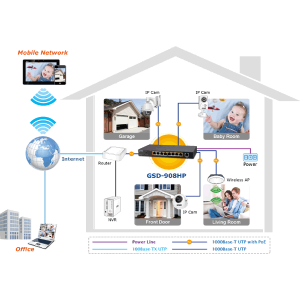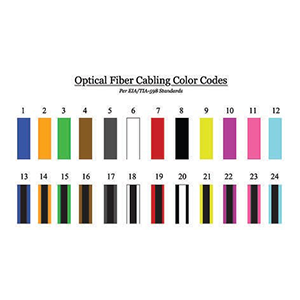In enterprise networks, fiber optic transmission technology plays a key role, and Cisco SFP modules are the core components for efficient fiber optic connections. This article will explain in detail how to identify the model of Cisco SFP modules and help you choose the module that best suits your network needs. We will introduce the basic functions and classification of SFP modules, explore the differences between single-mode and multimode optical fibers, and how to determine the module type through appearance, device configuration, and official documentation.
Knowing this information can not only help you optimize network performance, but also ensure the compatibility and stability of the equipment. If you need expert help to choose the right SFP module or optimize network configuration, please contact me. We provide professional services and solutions to help your network run more smoothly and efficiently!
What is Cisco SFP module
Cisco SFP modules (Small Form-Factor Pluggable) are hot-swappable fiber and copper cable interface modules that are widely used in Cisco switches and routers. They support a variety of network connection types, including fiber and Ethernet, providing flexible expansion and high-bandwidth transmission. SFP modules allow easy replacement and upgrade of interface types according to network requirements, achieving efficient network connection and optimization.
1. The role of SFP modules in Cisco network devices:
- Provide flexible fiber network connection:
- SFP modules are pluggable fiber transceiver modules.
- It is convenient to implement fiber interfaces on Cisco switches, routers and other devices.
- Support multiple transmission rates and distances:
- SFP modules support transmission rates ranging from 1Gbps to 10Gbps.
- It also supports different fiber transmission distance requirements.
2. Main categories of SFP modules:
- Single-mode fiber SFP module:
- Using single-mode fiber, suitable for long-distance transmission.
- The typical transmission distance can reach tens of kilometers.
- Multi-mode fiber SFP module:
- Using multi-mode fiber, suitable for short-distance transmission.
- The typical transmission distance is several kilometers or less.
In short, Cisco SFP modules provide flexible fiber interface options for network devices, supporting different transmission rates and distance requirements. According to the specific network deployment environment, you can choose the appropriate single-mode or multi-mode SFP module to meet the connection needs of the enterprise network.
Differences between single-mode and multimode optical fibers
The main differences between single-mode and multimode optical fibers are their core diameters and transmission distances. Single-mode optical fibers have a smaller core diameter (about 8-10 microns) and support long-distance, high-bandwidth transmission, suitable for inter-city or long-distance communications. Multimode optical fibers have a larger core diameter (about 50-62.5 microns) and are suitable for short-distance transmission, usually used in data centers or local networks. Single-mode optical fibers have less signal attenuation, while multimode optical fibers are suitable for short-distance applications with high data rates.
1. Working principles of single-mode and multimode optical fibers:
- Single-mode optical fibers transmit only a single beam of light:
- Single-mode optical fibers have a smaller core diameter and only allow a single mode of light waves to propagate in the fiber.
- Multimode optical fiber can transmit multiple light beams:
- Multimode optical fiber has a larger core diameter and can transmit multiple modes of light waves at the same time.
2. Comparison of the main characteristics of the two optical fibers:
- Single-mode transmission distance is long and cost is high:
- The transmission distance of single-mode optical fiber can reach tens of kilometers, but the cost is relatively high.
- Multimode transmission distance is short and cost is low:
- The transmission distance of multimode optical fiber is generally within a few kilometers, but the cost is relatively low.
3. Typical application scenarios of the two types of optical fibers:
- Single-mode is mostly used for backbone networks:
- Single-mode optical fiber is suitable for long-distance backbone network transmission, such as metropolitan area networks and wide area networks.
- Multi-mode is used for local area networks:
- Multi-mode optical fiber is suitable for shorter-distance local area network transmission, such as campus networks and enterprise campus networks.
In short, single-mode and multi-mode optical fibers have obvious differences in terms of working principles, transmission distances, and costs. Reasonable selection of the two types of optical fibers can meet the connection needs of networks at different levels and build efficient and reliable enterprise networks.
How to identify whether a Cisco SFP module is single-mode or multi-mode
You can identify whether a Cisco SFP module is single-mode or multi-mode by checking the model label or technical specifications of the module. Single-mode modules are usually marked as “SM” or “SMF”, such as “GLC-LH-SMD”, which are suitable for long-distance transmission; multi-mode modules are marked as “MM” or “MMF”, such as “GLC-SX-MMD”, which are suitable for short-distance transmission. You can determine the module type by checking these labels or consulting Cisco’s product documentation.
1. Identify from the appearance of the SFP module:
- Check the fiber type on the model or label:
- SFP modules usually clearly mark the fiber type as “single-mode” or “multi-mode” on the shell or label.
- Distinguish interface color (LC interface):
- The fiber interface of a single-mode SFP module is usually blue, and that of a multi-mode SFP module is green.
2. View through device configuration and information:
- Log in to the switch/router to view SFP information:
- Use the
show interface transceivercommand on the device CLI to view SFP module details.
- Use the
- Use the
show interface transceivercommand:- This command can display information such as the fiber type and rate of the SFP module.
3. Refer to Cisco official documents and specifications:
- Find the technical parameters of the SFP of a specified model:
- Check the technical specification documents of the relevant SFP modules on the Cisco official website.
- The document will clearly mark the fiber type of the SFP module.
Combining the above methods, you can accurately identify whether the Cisco SFP module is single-mode or multi-mode fiber. This helps to select the appropriate SFP module and ensure compatibility and reliability between network devices.
How to choose the right Cisco SFP module
To choose the right Cisco SFP module, you need to consider the following factors: transmission distance (select single-mode or multi-mode), data rate (such as 1G, 10G, etc.), interface type (fiber or copper cable), and wavelength (such as 850nm, 1310nm). Select the corresponding module according to network requirements and device compatibility, and refer to Cisco’s technical specifications and compatibility documents to ensure that the module matches the switch or router.
1. Select according to network topology and transmission distance:
- Ensure that the SFP matches the fiber type:
- Select single-mode SFP modules with single-mode fiber and multi-mode SFP modules with multi-mode fiber.
- The transmission distance meets the network requirements:
- Choose the appropriate SFP module transmission distance according to the network topology and distance requirements.
- Single-mode SFP modules are suitable for long-distance transmission, and multi-mode SFP modules are suitable for short-distance transmission.
2. Pay attention to the SFP power budget and compatibility:
- Ensure that the SFP is compatible with the interface power consumption:
- Check whether the SFP module power consumption meets the power supply capacity of the device interface.
- Check whether the model is Cisco certified:
- Give priority to original SFP modules certified by Cisco to ensure compatibility.
- Using uncertified third-party SFP modules poses a compatibility risk.
Taking into account factors such as fiber type, transmission distance, power consumption, and compatibility, choosing the right Cisco SFP module is essential to building a reliable fiber network. Correctly selecting SFP modules can not only ensure compatibility between network devices, but also meet the requirements of network topology and transmission distance, and improve the overall stability and reliability of the network.
Summary
Through this article, you have mastered how to identify and select single-mode or multimode fiber for Cisco SFP modules. Understanding fiber types and module specifications is essential to ensure network performance and stability. If you encounter problems when selecting SFP modules or other network devices, our professional team is ready to help you at any time.
Whether it is network optimization or device selection, we can provide you with the most suitable solution to ensure that your network environment runs efficiently. Choose us, you will enjoy high-quality technical support and services to fully meet your network needs!
Cisco SFP is single mode or multimode FAQ
You can check the part number printed on the SFP module itself or run the command show inventory on the switch to display the SFP’s specifications, which will indicate whether it is single-mode (SM) or multi-mode (MM).
Single-mode SFPs (SM) are typically used for long-distance fiber connections, while multi-mode SFPs (MM) are designed for shorter distances and use wider core optical fiber.
Yes, single-mode SFPs usually have blue or yellow labels, while multi-mode SFPs have black or beige labels. However, always verify the exact model number for confirmation.
Use the show interfaces transceiver command, which will display detailed information about the installed SFP module, including the type of fiber it supports.
Common part numbers for single-mode SFPs include GLC-LH-SM and SFP-10G-LR, while multi-mode SFPs often have part numbers like GLC-SX-MM and SFP-10G-SR.
Single-mode SFPs are capable of longer distances, typically up to 10 km or more, whereas multi-mode SFPs support shorter distances, usually up to 550 meters.
No, single-mode SFPs should only be used with single-mode fiber, and multi-mode SFPs should be used with multi-mode fiber. Mixing them may result in poor performance or no connection.
Single-mode SFPs typically operate at a wavelength of 1310nm or 1550nm, while multi-mode SFPs operate at shorter wavelengths such as 850nm.
Yes, single-mode SFPs tend to be more expensive due to their long-distance capabilities, while multi-mode SFPs are generally more affordable and suited for short-range connections.
No, multi-mode SFPs are designed specifically for multi-mode fiber optic cables, and using them in a single-mode environment would not provide proper connectivity or performance. Always match the SFP type with the corresponding fiber type.



